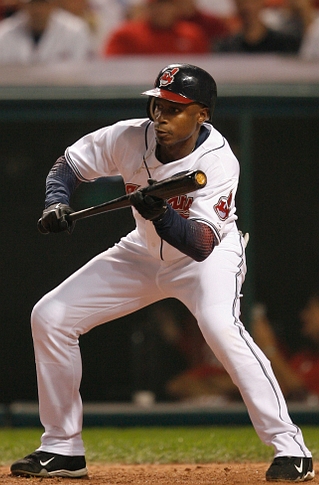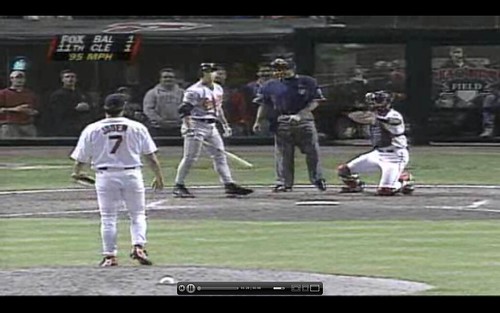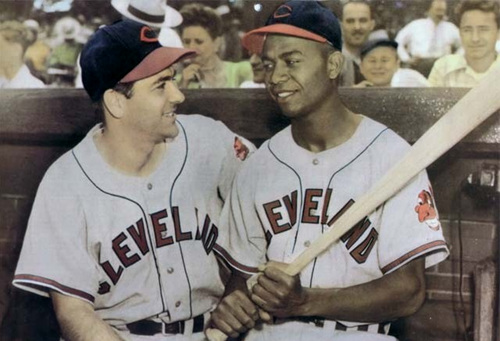 Indians Archive
Indians Archive  Numbers Game
Numbers Game
 We, as fans of sport in the year 2012, live in a world where greatness cannot simply be defined by the eyeball test of what we consider to be success without having a conversation about being the greatest ever. We have to talk about statues, re-naming streets, the Hall of Fame, and retired numbers. We debate who gets a statue, who deserves one, and who does not. Sometimes it’s all about the numbers, and at times, it’s more about fanfare or the meaning behind commemoration above all else.
We, as fans of sport in the year 2012, live in a world where greatness cannot simply be defined by the eyeball test of what we consider to be success without having a conversation about being the greatest ever. We have to talk about statues, re-naming streets, the Hall of Fame, and retired numbers. We debate who gets a statue, who deserves one, and who does not. Sometimes it’s all about the numbers, and at times, it’s more about fanfare or the meaning behind commemoration above all else.
At the ballpark in Cleveland, among the numbers of the legends of yesteryear, you might notice the number 455, which honors the fans who sold out Jacobs Field for that many consecutive games. At the time of that sellout streak, it was a Major League Baseball record, which has since been surpassed by the bandwagon in New England getting on board with the Red Sox in the midst of two World Series titles in four years. Since 1997, every team in baseball honors the number 42, to honor Jackie Robinson breaking the color barrier in 1947. Of course, every team also honors their own greats by “retiring” uniform numbers as well.
In addition to the 455, you’ll see Earl Averill’s 3, Lou Boudreau’s 5, Larry Doby’s 14, Mel Harder’s 18, Bob Feller’s 19, and Bob Lemon’s 21 on the rafters in Progressive Field’s right field mezzanine. They weren’t all part of Championship teams, and not every one of them is in the Hall of Fame, but it’s difficult to make an argument against any one of them being honored with uniform number retirements. What I find difficult is that no player has been recognized by the team since Doby in 1994, and he last played in 1959, which means the organization is allowing at least one great era of baseball in Cleveland to be forgotten.
For someone my age, a child of the 80’s and 90’s, the entertainment value created by the teams of the early Jacobs Field era (call it 1994-2001) in stark contrast to the teams of the late Cleveland Stadium era made baseball a real thing for a significant period of time. The allure of the new state-of-the-art ballpark probably brought fans in for a time, and it is nice that the fans are indeed honored, but there were certainly teams that kept the momentum going, and players that made those teams great for such an extended amount of time. Yet, the ballpark at Carnegie and Ontario compliments six division championships and two American League pennants with zero players from a great era of baseball in Cleveland.
 So, I’d like to make a case for Kenny Lofton, a man who retired with no World Series rings, who will only go to Cooperstown if he ever chooses to visit. In his seventeen year career, the six-time All-Star did play for ten other teams, including the division rival White Sox and universally hated Yankees. However, the argument against retiring his number 7 stops right there. In his role as a lead-off hitter, he was in a class of his own. He stole 452 bases in an Indians uniform, almost twice as many as anyone else in team history, a category he led the league in for five consecutive seasons. His 160 hits in the strike-shortened 1994 season was also a league best, and his 13 triples in the abbreviated 1995 season were also an American League best. He never finished higher than fourth in the MVP vote (1994), but he did represent the Indians five times in the All-Star game, and was recognized for his outstanding defensive play in center field by earning a Gold Glove each year from 1993-1996.
So, I’d like to make a case for Kenny Lofton, a man who retired with no World Series rings, who will only go to Cooperstown if he ever chooses to visit. In his seventeen year career, the six-time All-Star did play for ten other teams, including the division rival White Sox and universally hated Yankees. However, the argument against retiring his number 7 stops right there. In his role as a lead-off hitter, he was in a class of his own. He stole 452 bases in an Indians uniform, almost twice as many as anyone else in team history, a category he led the league in for five consecutive seasons. His 160 hits in the strike-shortened 1994 season was also a league best, and his 13 triples in the abbreviated 1995 season were also an American League best. He never finished higher than fourth in the MVP vote (1994), but he did represent the Indians five times in the All-Star game, and was recognized for his outstanding defensive play in center field by earning a Gold Glove each year from 1993-1996.
The numbers are what they are, and maybe it feels like a reach, especially if you don’t value the stolen base very much, but Lofton’s contributions do exceed what you see in the box score. Starting with his defense, where he patrolled center field in the role of Kelly Leak, forced to catch any fly ball that his legs would take him to because of the liabilities that existed with Albert Belle and Manny Ramirez on the corner spots in the outfield. Though he did leave the team twice, he did return twice, he also returned twice, and always to the open arms of Tribe fans. Here’s the big thing; since 1955, the Indians have reached the post-season just seven times, and Lofton has been on six of those teams.
I have to admit to doing a bit of cherry picking here, but some of his post-season stats are extremely impressive. In 1995, his .458 batting average and 5 base swipes led Cleveland to their first World Series since 1954. He book-ended his post-season success in the 2007 Division Series against the Yankees with a .375 average, and that was as more of a role player. In looking at his post-season experience on the whole, it’s a true case of hard luck. From the 2002 Giants to the 2003 Cubs, and the unforgettable collapse of the 2004 Yankees, it’s hard to believe that Lofton was part of all those near-misses. And, that’s a list of hard luck teams before you even get to the last 3 games of his fine career, the ones in a Cleveland uniform, where a victory over Boston gets him to his third World Series with a good chance to win over Colorado. We all know how that one ends, but we mostly remember that he’s standing on third base after an unexplainable stop sign, a fine metaphor for how we feel as fans of this franchise and all of Cleveland sports.
 Do you need another reason to say goodnight to the number? I’ll give you two; Jeff Juden and Matt LaPorta have both donned the number at times when Lofton was not on the roster. If you aren’t familiar with Juden, he threw 31 unspectacular regular season innings and three more unimpressive post-season innings in 1997. He, in fact, appeared in two World Series games against the Marlins, and left the Indians in worse shape on the scoreboard than they were when he entered. The best highlights of Juden’s time with the Tribe, aside from the uniqueness of being a pitcher in single digits, were how he was traded in and out of town. He came to Cleveland in a trade that sent Steve Kline of GQ bully fame out of town, and left after the ’97 season with Marquis Grissom, which created a vacancy in center field for Lofton to return as a free agent.
Do you need another reason to say goodnight to the number? I’ll give you two; Jeff Juden and Matt LaPorta have both donned the number at times when Lofton was not on the roster. If you aren’t familiar with Juden, he threw 31 unspectacular regular season innings and three more unimpressive post-season innings in 1997. He, in fact, appeared in two World Series games against the Marlins, and left the Indians in worse shape on the scoreboard than they were when he entered. The best highlights of Juden’s time with the Tribe, aside from the uniqueness of being a pitcher in single digits, were how he was traded in and out of town. He came to Cleveland in a trade that sent Steve Kline of GQ bully fame out of town, and left after the ’97 season with Marquis Grissom, which created a vacancy in center field for Lofton to return as a free agent.
Then, you have a the ongoing saga of Matthew Vincent LaPorta, who cannot hit Major League pitching. Of course, it isn’t his fault that he was the primary piece in a lopsided trade that sent CC Sabathia to Milwaukee, where he carried the Brewers into the post-season on his back. LaPorta, who came over with Michael Brantley, Rob Bryson, and Zac Jackson in the 2009 blockbuster trade, was a sensational AA outfielder, hitting .288 with 20 HR thru 84 games with Huntsville. It was okay when he wore an offensive lineman’s number in Goodyear in 2009, and even when he was initially called up wearing the number 16, but when the .237 career hitter started wearing Kenny Lofton’s number, that’s when I began to take issue with it.
I’m fully aware that you can’t politick for a number to be retired simply because you don’t like the turd that currently wears the number, but there are real numbers that actually are retired because being better than LaPorta isn’t what merits a spot in the mezzanine. Understanding that numbers in baseball mean different things in different eras, Lofton stacks up with some of the legends that the Indians have already bestowed this honor upon.
 Earl Averill isn’t much of a household name when it comes to bar room conversations about old school baseball, but there is no doubt that his number deserves to be retired, and that he belongs in the Hall of Fame. Like Lofton, he is a six-time All-Star, but there were no All-Star games before 1933, his fifth season, so that number is a bit misleading. His Triple Crown numbers were off the charts in his time with the Indians, though he never led the league in one of the categories; per 162 games, he hit .322 with 24 home runs and 116 RBI. In 1936, his 232 hits and 15 triples were the best the American League had to offer; Lofton also once led the league in hits and once in three baggers. Lofton’s number would be in good company with Averill’s.
Earl Averill isn’t much of a household name when it comes to bar room conversations about old school baseball, but there is no doubt that his number deserves to be retired, and that he belongs in the Hall of Fame. Like Lofton, he is a six-time All-Star, but there were no All-Star games before 1933, his fifth season, so that number is a bit misleading. His Triple Crown numbers were off the charts in his time with the Indians, though he never led the league in one of the categories; per 162 games, he hit .322 with 24 home runs and 116 RBI. In 1936, his 232 hits and 15 triples were the best the American League had to offer; Lofton also once led the league in hits and once in three baggers. Lofton’s number would be in good company with Averill’s.
There’s more than meets the eye with Lou Boudreau’s bottom line. He was a career .295 hitter, who primarily played shortstop for the Indians, but also managed the club from 1942-1950, making him the last Tribe skipper to take a Cleveland professional baseball club to the promised land in 1948. It was more than just him managing that team; he batted .355 with 18 home runs and 106 RBI in that championship season. It was his 4-for-4, 2 HR performance in a 1-game playoff against the Red Sox that propelled the Indians to an 8-3 victory and a title shot against Boston’s National League team that year. Obviously, Lofton stole more bases, there were six different seasons where Lofton stole more than Boudreau did in his 13 years with the Tribe, and he also averaged slightly more hits per season, but no one in their right mind would argue that Lou’s number 5 belongs in the regular rotation of number assignments.
 That brings us to Lawrence Eugene Doby, the Jackie Robinson of the American League. Yes, he was the first African-American player to appear in an American League game on July 5, 1947, but there was more to his career than just the symbolism of the American League color barrier. Aside from appearing in both the 1948 and 1954 World Series, he led the American League in Runs, HRs (twice), RBI, On-Base Percentage, and Slugging Percentage. He finished second in the MVP voting to Yogi Berra in 1954 by a slim margin, and was named to the American League All-Star team 7 times. The Indians retired his number 14 in 1994, and the Veterans Committee named him to the Hall of Fame in 1998. He wasn’t a base-stealer like Lofton, but he fielded his position in center field very well, and his fielding percentage in the outfield was nearly identical to Lofton’s.
That brings us to Lawrence Eugene Doby, the Jackie Robinson of the American League. Yes, he was the first African-American player to appear in an American League game on July 5, 1947, but there was more to his career than just the symbolism of the American League color barrier. Aside from appearing in both the 1948 and 1954 World Series, he led the American League in Runs, HRs (twice), RBI, On-Base Percentage, and Slugging Percentage. He finished second in the MVP voting to Yogi Berra in 1954 by a slim margin, and was named to the American League All-Star team 7 times. The Indians retired his number 14 in 1994, and the Veterans Committee named him to the Hall of Fame in 1998. He wasn’t a base-stealer like Lofton, but he fielded his position in center field very well, and his fielding percentage in the outfield was nearly identical to Lofton’s.
There’s an obvious issue with retiring Kenny Lofton’s number because it does open up Pandora’s box for some of the other great Indians of the era. Jim Thome, the franchise home run king is getting a statue, and appeared on every playoff team of the Jacobs Field Era, except one (2007). He even returned to somewhat of a hero’s welcome in 2011, however brief that return may have been. Then, you had Albert Belle, who was about as good as they came on the field for about a four year stretch from 1993-1996, even if we had a hard time with who he was off the field. Belle was always in the MVP discussion, and was arguably black-balled for the award because of the character that he was or wasn’t, depending on how you look at it. Manny Ramirez put up some incredible numbers in his time with the Indians as well, but like Belle, it might be difficult for the Indians to honor him because of the nature of his departure via free agency. And, we obviously can’t just decide that we’re going to retire four or five numbers.
If the Indians want to honor that era, and I think they should, it’s in their best interest to pick at least one player. Lofton was arguably the catalyst that set the wheels in motion on the greatest era of baseball Cleveland had seen in half of a century, giving us a preview of things to come in the last years of Municipal Stadium. It’s still weird to see someone else wearing that number 7, someone who doesn’t bring the excitement to the game the way that Lofton did. It might be the right thing to do, and it might not be.
It’s just something that I think about, and I think about it more often than you might think.
- NBA Announces 2013-2014 Schedule
- Browns Ink Sharknado
- Sharknado A No-Show For Rookie Camp
- Trent Richardson Out Until Training Camp
- Browns Sign Brandon Jackson
- Carrasco Suspended Eight Games
- Browns Add to Wide Receiver Depth with David Nelson
- Browns Need to Learn from Past Draft Mistakes
- Browns Release Chris Gocong and Usama Young
- Browns Missing on Grimes Disappointing, But Not The End
The TCF Forums
- Chris Grant's first 3 drafts
Kingpin74 (Tuesday, January 21 2014 10:13 AM) - The 2014 Offseason Thread
googleeph2 (Tuesday, January 21 2014 9:36 AM) - 2015 Recruiting
furls (Tuesday, January 21 2014 6:57 AM) - Mike Brown
YahooFanChicago (Monday, January 20 2014 11:15 PM) - Movies coming out
HoodooMan (Monday, January 20 2014 9:34 PM) - 2014 Hoops Hockey Hijinx
jpd1224 (Monday, January 20 2014 4:44 PM) - 2014 Recruiting
jclvd_23 (Monday, January 20 2014 2:26 PM) - Wish List - #4 Pick
Hikohadon (Monday, January 20 2014 1:26 PM) - Official- Browns Coach Search/Rumors
OldDawg (Sunday, January 19 2014 6:48 PM) - #1 overall pick Anthony Bennett
TouchEmAllTime (Sunday, January 19 2014 1:28 PM)


